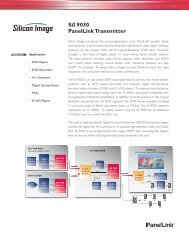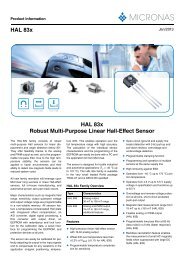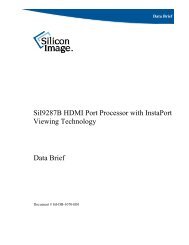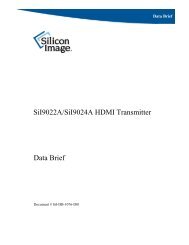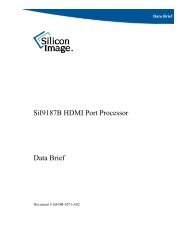Create successful ePaper yourself
Turn your PDF publications into a flip-book with our unique Google optimized e-Paper software.
<strong>UAC</strong> <strong>357xB</strong><br />
ADVANCE INFORMATION<br />
2.7. Power Supply<br />
The <strong>UAC</strong> <strong>357xB</strong> has on-chip voltage regulators providing<br />
the optimal supply voltages for the analog and digital<br />
sections, thus allowing to power the IC by the USB<br />
Bus supply lines, as well as from external supply. They<br />
also serve to reduce cross-talk and EMI.<br />
For stable operation, all regulators need external<br />
capacitors.<br />
2.8. I 2 C Bus Interface<br />
Pins: SDA, SCL<br />
The <strong>UAC</strong> <strong>357xB</strong> is equipped with an I 2 C bus master/<br />
slave interface. Bus format and timing follow the original<br />
specification for I 2 C (The I 2 C Specification V2.1).<br />
It operates with 5 V signalling at 100 kHz or 400 kHz.<br />
Both master and slave mode require support from the<br />
microcontroller firmware.<br />
The regulators are<br />
1. VREG:<br />
3.4 V regulator for USB-signalling (saving external<br />
regulator)<br />
2. AREG0:<br />
3.5 V regulator for analog back-end<br />
3. AREG1:<br />
3.5 V regulator for analog circuitry apart from backend.<br />
Reference voltage for analog signals:<br />
SREF:<br />
1.7 V (optional 2.3 V) reference voltage for analog circuitry.<br />
In applications, for example home stereo equipment<br />
with noisy ground levels, however, it is better that<br />
the reference follows the AC-<strong>com</strong>ponent of the external<br />
ground system. This results in a <strong>com</strong>pensation of<br />
the noise. This AC-<strong>com</strong>ponent can be coupled into pin<br />
SREF0.<br />
Note: It is re<strong>com</strong>mended for AVSS0/1, SGND and<br />
VSS to be connected.<br />
2.8.1. I 2 C Master<br />
This mode allows control of external I 2 C devices, such<br />
as EEPROMs, LCD-Displays etc. This interface is<br />
used to download configuration data and firmware<br />
from an EEPROM after power-up. The bus protocol<br />
(subaddressing and packet length) is defined by firmware<br />
and therefore programmable.<br />
Note: Micronas standard firmware (Section 4. “Firmware”<br />
on page 22) provides support for USB to<br />
I 2 C bridging, allowing control of I 2 C devices via<br />
USB.<br />
2.8.2. I 2 C Slave<br />
In I 2 C slave mode, the interface provides an interrupt<br />
to the microcontroller after detecting the assigned I 2 C<br />
address (0x48). The corresponding interrupt service<br />
routine handles this request and interprets in<strong>com</strong>ing<br />
data according to the application.<br />
One example of handling could provide full access to<br />
all memory locations.<br />
Five-Volt Mode<br />
If a higher output level is required, the IC can operate<br />
in 5 V mode. In this case, the IC is powered from an<br />
external 5 V supply: AVDD has to be connected to<br />
AREG0 and AREG1 and SREF must be switched to<br />
5 V mode.<br />
12 Aug. 20, 2004; 6251-650-1AI Micronas


